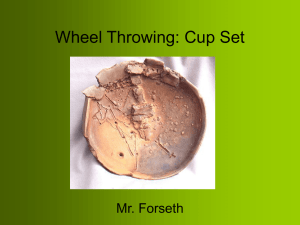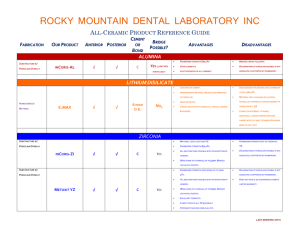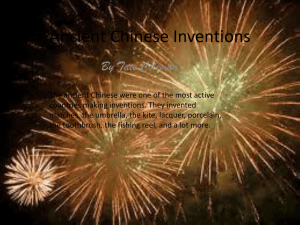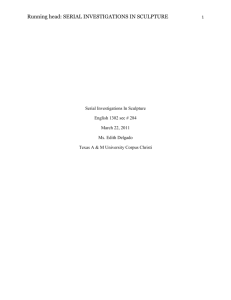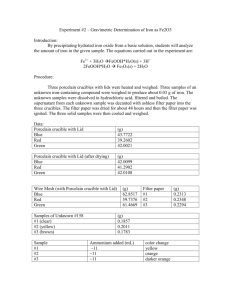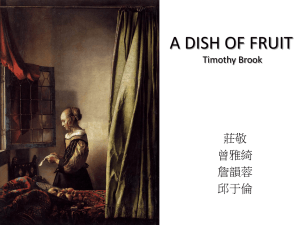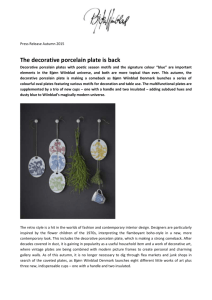Porcelain trade - University of Warwick
advertisement
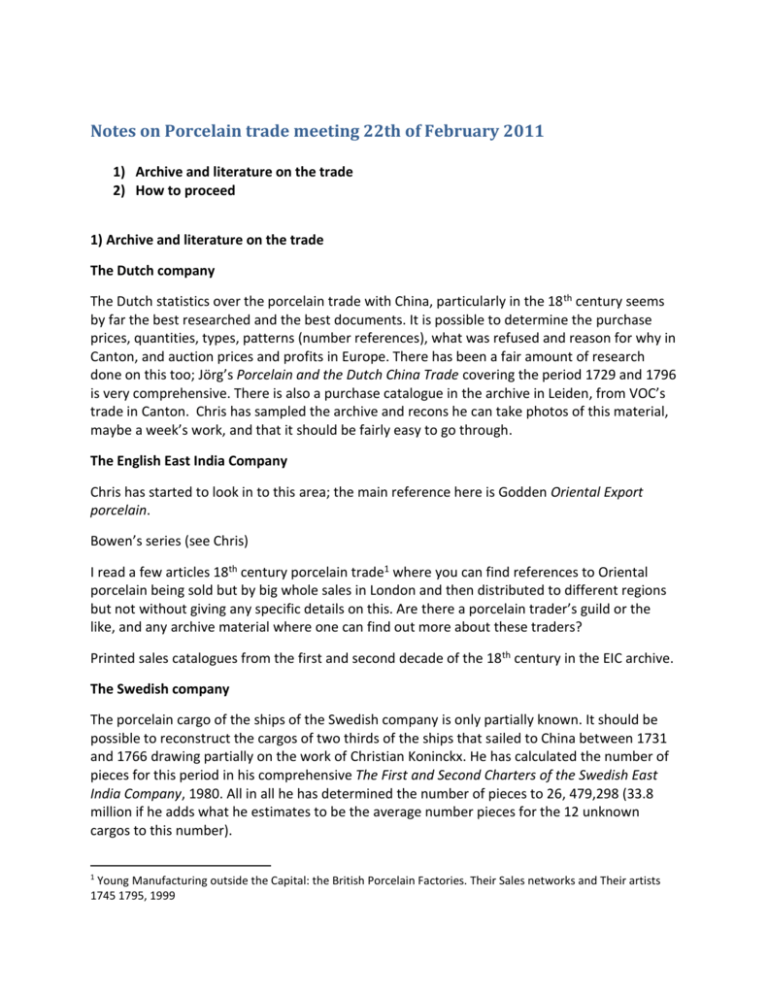
Notes on Porcelain trade meeting 22th of February 2011 1) Archive and literature on the trade 2) How to proceed 1) Archive and literature on the trade The Dutch company The Dutch statistics over the porcelain trade with China, particularly in the 18 th century seems by far the best researched and the best documents. It is possible to determine the purchase prices, quantities, types, patterns (number references), what was refused and reason for why in Canton, and auction prices and profits in Europe. There has been a fair amount of research done on this too; Jörg’s Porcelain and the Dutch China Trade covering the period 1729 and 1796 is very comprehensive. There is also a purchase catalogue in the archive in Leiden, from VOC’s trade in Canton. Chris has sampled the archive and recons he can take photos of this material, maybe a week’s work, and that it should be fairly easy to go through. The English East India Company Chris has started to look in to this area; the main reference here is Godden Oriental Export porcelain. Bowen’s series (see Chris) I read a few articles 18th century porcelain trade1 where you can find references to Oriental porcelain being sold but by big whole sales in London and then distributed to different regions but not without giving any specific details on this. Are there a porcelain trader’s guild or the like, and any archive material where one can find out more about these traders? Printed sales catalogues from the first and second decade of the 18th century in the EIC archive. The Swedish company The porcelain cargo of the ships of the Swedish company is only partially known. It should be possible to reconstruct the cargos of two thirds of the ships that sailed to China between 1731 and 1766 drawing partially on the work of Christian Koninckx. He has calculated the number of pieces for this period in his comprehensive The First and Second Charters of the Swedish East India Company, 1980. All in all he has determined the number of pieces to 26, 479,298 (33.8 million if he adds what he estimates to be the average number pieces for the 12 unknown cargos to this number). 1 Young Manufacturing outside the Capital: the British Porcelain Factories. Their Sales networks and Their artists 1745 1795, 1999 In his appendix Konninckx also lists number of pieces brought in on every ship (43 expeditions out of 55). He has also created a graph illustrating the development of this trade. He does however not specify what type of porcelain this is (e.g. plates, pots, cups). Neither does he specify where more precisely he got the information from, he mentions (briefly) that he used 36 sales catalogues, some packing lists, and invoices but does not specify the name or location of this material (note he has not used newspaper material, which in some cases gives information on the 12 missing cargos). It might take me a bit of time to reconstruct Konnickx’s list so as to get a more detail list including what type of porcelain was brought in during the first two charters. The archive material relating to the Swedish East India is spread over 10 different archives.2 However, I am hoping maybe Konnickx can help, he is still active, I made contact with him to ask him about his statistics and he has promised to get back to me. I am hoping he can provide me with some guidance or possible if he did break down the numbers into different types of porcelain working on this series does he still have the material For the Third Charter (between 1766 to 178.6) there one list available in Kullberg’s study (Svenska Ostindiska Compagnierna 1731-1813, 1974) which counts the total number of porcelain pieces to 11, 343,263 he also breaks down this into 20 something categories (note however Koninickx claims that with his method for calculating which includes counting pairs as two, the total number for this period should be 18,995,745). There is also a rare print from 1879 which lists (Wilhelm Berg Om införseln till Sverige af kinesiskt porslin 1766-1786) which probably will be useful, when I get hold of it. There is also quite comprehensive number of invoices and packing lists for this period, the latter which I had a look at on-line, they contain a little more information on colours and designs, than the sales book, where the information is very sparse. The forth charter I found out very little about, in general there seems to be have been a decline in the import of Chinese porcelain to Europe generally and Kjellberg for example says that that was the case with the Swedish company too, so very little was brought in. The Danish Company Numbers for the amounts and types of porcelain brought over the Danish company I have struggled finding out more information about. As far as I can gather this has at least partially to do with archive material failing, something also the literature I have read suggest (articles and books by Glamann, Feldbeak, Rasch, Sveistrup, Gøbel, and others). Rasch and Sveistrup (Asiatisk Kompagni i den florissante Periode 1772-1792, 1948) lists porcelain cargo from one ship they describe as typical for the period the cover, but it is not too detailed, although it is promising they say it is detailed saying there should be comparable material elsewhere. The only literature that I found relating specifically to Danish porcelain trade is Bredo Grandjean, 2 21 of the sales catalogues are located in one place, Riksarkivet, in Stockholm, Dansk Ostindisk Porcelæn Importen fra Kanton ca. 1700 – 1822, 1964, which I now read and which in some instances some very detail accounts of porcelain ordered. I found frequent references to sales catalogues from the period 1753-57, and comments suggesting they are the only reminding ones.3 I also had a look at material relating to Asiatisk Compagni (1732-1808) archive material listed in the State Archive in Copenhagen, the lists here suggest that there are comprehensive material relating to the trading with China, containing accounts of the purchases.4 There are also a lot of promising material relating to the China trade possibly including directions on how conduct the trade, and what to buy, from Copenhagen.5 This archive also allows photographs so I should be able to go gather a lot of material quickly when I go to Copenhagen. The French East Indian Companies Personal Allowances Stats on the return cargos are usually based on bills of lading and mainly on auction lists. As far as I can tell these do not include either personal allowances of the sailing personnel, nor goods carried free of freightage. These could be very substantial – Dermigny seems to think that in the case of the EIC most of the porcelain imports were done privately via personal allowances. Private Trade Private trade in the later seventeenth century doesn’t seem to distort the stats a lot, since private traders were obliged to ship on company ships and sell at company auctions. More of a problem is the private trade of the Saint Malo companies founded around the turn of the century, like the Companie de la Chine, as far as I can see they only needed to pay an indemnity to the company, so would not, I think, pop up in the statistics. In the first two decades of the eighteenth century (i.e. before the establishment of the Law company) the company mainly just leased out privileges, so this further complicates things. I will have to look into this more, but I don’t think the imports of this private trade are counted in the statistics. 3 Geheimeråd A.G. Moltkes eksemplarer af auktionsprotokoller over bortsolgte ladninger fra Det Asiatiske Kompagnis skibe (officielt) 4 Auktionsregnskaber over indk. ostindiske og kinesiske varer 1786 – 1839; Balancer af Asiatisk Kompagnis hovedbøger 1732 – 1841; Hovedbøger for ekspeditioner til Kina 1782 – 1833; Kasse- og hovedbøger fra kinaskibene 1734 – 1772; Kasse- og hovedbøger fra kinaskibene 1734 - 1772 5 Europæiske breves kopibog 1773 – 1845; Indianske og chinesiske Breves Copie Bog 1757 – 1840; Indkomne breve fra faktoriet i Canton 1773 – 1791; Instructions Bog for China etc. 1777 – 1796; Instructions Copie Bog for Capitainerne paa China No. 20 1757 – 1770; Instructions Copie Bog for Ober- og Under-Mestre paa China. No. 23 (officielt); Instructions Copie Bog for Præsterne paa China. No. 22 1758 – 1771; Instructions Copie Bog for Skibs Assistenterne paa China, No. 21 1757 – 1771; Instruktionsbog for Negotiebetjentene paa China 1796 – 1805; Kinesiske ekspeditioners kopibog 1735 - 1762 After the 7 Years War, especially after the loss of the Company monopoly in 1769 private trade again flourished until the mid 1780s. The Chinese trade especially became very important. This might not necessarily distort statistics, because private traders were required to put into Lorient, even though later they were allowed to unload at Nantes. However, I do not know if they are included in the stats collected by Haudrère and Wellington and I am quite sure that after the official end of the monopoly private trade did not have to be part of Company auctions, so that after 1770 the statistics from these (and that is what most statistics are based on) are pretty useless. There is however one document in the Archives that is a government overview of French trade with India and China between 1775 and 1780. Wellington quotes this, but, whilst I haven’t had a look at it myself, I’m not sure whether it gives any detail (i.e. whether it mentions anything on porcelain) and how reliable it is. Monopoly trade returned for a few years with the Calonne Company of 1785 but ceased under the French Revolution. Smuggling I think we can be carefully optimistic here. Smuggling seems not to distort the estimates much, since it appears to have been largely focussed on coffee and fabrics. I of course cannot prove that though. Conversions Haudrère’s proposes conversion of 1,000 pieces per case and 100 per roll seems the most convincing. He bases this on several different sources in the Archives nationales, the Bibliothèque nationale, and the Archives of Lorient’s port. For tableware sets he counts 122 for colour and 112 for blue and white sets. This is based on a different document in the Archives nationales. These estimates also correspond to those given by Louis Dermigny in his 1964 Commerce à Canton, who follows Morse in this. There is an earlier estimate by Tournier: ‘La porcelaine des Indes d’après les archives de la Compagnie française des Indes’ (1953). This comes up with a different count (I couldn’t get hold of this yet, so I don’t know his count). Also different is the conversion operated by Wellington, who takes cases and rolls, as they are often quoted interchangeably to have the same content, equalling 300 pieces. He gives three references for this, though the two from Aix might just be examples of both being quoted interchangeably, whilst the third, from Lorient, must be his evidence for the number of 300. I’m not very convinced by that, but a contemporary source (Les Mémoires de Constant sur le commerce de la Chine) does actually give 300 per case as well. Available dates and stats Auction data is patchy, especially for the seventeenth century. For the ‘golden years’, i.e. 17201740 auction lists are available for almost all years. On the problems in accounting for private trade, especially between 1700-1720 and 1769-1785, see above. We can of course neglect private trade and just talk about company trade, but we should bear in mind that for certain periods the picture would be distorted by leaving private imports out. So to have reliable statistics the best period (and the one Haudrère focuses almost all his stats on) is 1720-69. I think Wellington is probably wrong in his conversions, which would make his overall totals unusable. In his more detailed lists, he sometimes gives numbers of cases and rolls individually, but also the individual types of porcelain items when he has them. They are included in the overall count. An overview of the available statistics is in a separate document. They don’t seem in any way coherent and thus strike me as rather useless. Given the problems with the piece count and the hugely varying numbers, it might be more helpful to look at the value instead. Value at auctions should be fairly easy to establish, Wellington gives numbers for this, but it might be very difficult to compare this with buying price to establish a profit margin, as there would be the problem of personal allowances and hence personal purchases coming in. It should however be fairly easy to establish value of porcelain sales as a percentage of overall sales value. Production There are several contemporary French sources on porcelain production in China, the best known would probably be the Encyclopédie article ‘Porcelaine’ (‘Porcelaine de la Chine, Art de la poterie’) by Jaucourt, and two earlier letters on the topic by the Père d’Entrecolles in the widely read Lettres Edifiantes (letters from September 1712 and January 1722, in volumes 12 and 16 respectively), which are used in Du Halde’s, the Lettres’ editor, Description [...] de l’Empire de la Chine of 1735. Taxation Until 1726 Porcelain still falls under the original regulation of 1664, which (I think) means a tax of 3% on its value. From 1726 all porcelain imports have to pay a tax of six pounds (livre tournois that is) per quintal on entry into France. From 1757 this rises to 100 pounds for all but the Company’s imports, which remain at six pounds (See Haudrère, vol. II, note 260). In general, a lot of the taxes did not apply to the regions of France falling under the category ‘provinces reputes étrangères’, Britanny for instance. However I’m not sure if this also applied to porcelaiin. Bibliography Beurdeley, ‘Chinese porcelain in French regional museums’, Orientations (Hong Kong), 1994, (25, 12), 50-58 Crick, ‘Trade with France – Le commerce avec la France’, Oriental art, 1999 (45, 1), 5259 Louis Dermigny, La Chine et l'Occident : le commerce à Canton au XVIIIe siècle, 17191833 (Paris : S.E.V.P.E.N 1964) 4 vols Philipe Haudrère, La Compagnie française des Indes (Librarie de l’Inde, 1989) Huard Pierre, Wong Ming, ‘Un album chinois de l'époque Ts'ing consacré à la fabrication de la porcelaine’, Arts asiatiques, 9 (1962), 3-60 D. F. Lunsingh Scheurleer, Chinese export porcelain – Chine de commande (London : Faber 1974) Tournier: ‘La porcelaine des Indes d’après les archives de la Compagnie française des Indes’, Bulletin et mémoires de la Société archéologique du département d'Ille-et-Vilaine, 1953 (69) 23-28 Donald C. Wellington, French East India Companies : A Historical Account and Record of Trade (Lanham: Hamilton, 2006) 2) How to proceed A Dutch main porcelain import series and a series of case studies on the other companies With the records of the Dutch trade being by far the most comprehensive and by the sound of it easily available, it might be an idea to use this data to create a general statistical series. With this as a reference point we could do case studies of the other companies. The Dutch numbers might enable us to identify specific periods when the porcelain trade underwent dynamic changes, not only in terms of the quantity of items imported but (possibly more interesting) also looking into changes of a more qualitative art, e.g. can we establish increases in imports of cups and sets, changes in color schemes, shapes, increase of varieties of porcelain offered. With this in mind we could select some more specific periods to study the import of the other companies and correspondence concerning this import too. Pairing cups with content and use (tea cups, tea, afternoon tea) chocolate cups and cacao, coffee cups and coffee beans) Another idea could be to match the statistics over import of porcelain cups with existing statistics over import of tea, chocolate and coffee to different parts of north west Europe. We might be able to say something about the consumer market in NW Europe becoming more integrated and inter-dependent. Growing coffee, tea and cacao import, growing porcelain import of cups for these specific beverages suggest a more specific market… (is this very banal?). Did individuals buy cups before they could afford the beverages etc. Does the growing (I assume) number of porcelain utensils indicate a more ware and tear approach to porcelain objects? From ornamental to practical… Comparing the imports of sets of porcelain, the growing size of the sets might also be possible to connect changing consumer habits. Comparison and case studies might also enable us to say something intelligent about the smuggling of goods to Britain particularly. We know that a great amount of tea was smuggled to Britain (see particularly studies by Mui6) from the continent. Can we assume that tea cups went the same way, (maybe hard to argue something here since the British statistics on porcelain import is hard to come by); i.e. did the two goods continue to travel together? There is a discussion here on the difference between coffee and tea drinking nations, the flavor for coffee in the US, one obvious example. Sweden another example; tea was generally a beverage for the elite in the 18th century but it is coffee that becomes the favorite of the people and then in the 19th century and onwards, in which case it might be interesting to discuss the changing number of tea versus coffee cups imported from China and see how they change over time. Instructions on handling, packing and purchasing The communication on porcelain trade within the different companies could be used in several different ways. 1) Instructions on packing should give us clues how to estimate cargoes which are not broken down into different items, i.e. help us with some of the statistical work. 2) Chris found very interesting comments on the reasons Dutch supercargoes for rejecting certain goods in China, reasons which are listed in material produced in Canton. These comments and similar should enable us to say something about the growing awareness and concerns about what would sell on the European market which can analyze in the light of our statistical series. 6 Hoh-cheung Mui and Lorna H. Mui, The Management of Monopoly. A Study of the East India Company’s Conduct of its Tea Trade 1784-1833, University of British Colombia Press, Vancouver 1984, and Idem, "Trends in 18th century Smuggling Reconsidered", Economic History Review, 1975 3) As we talked about on Friday, pattern numbers for porcelains, e.g. from the start the Swedish company used numbers to refer to patterns (and models?) which they used in the lists over purchased porcelain, the same numbers were used in the sales catalogues. This suggest a whole sale approach to selling porcelain, efficient and good for buying bulk. A discussion on this can link up to discussions in Business history on the developments of early modern trade, e.g. compare Zahedie7 on trends in the Atlantic trade where merchants demonstrated a growing awareness of and interests in issues to do with making goods similar, so they could be more easily packaged and sold. We can compare that to the private trade and the ordering and selling of armor porcelain took place. T Auctions, marketing, buying, smuggling In general there seems to be very little on the auctioning of the goods, Jörg has written one article “To the Highest Bidder: The Auction of a Porcelain Shop in Amsterdam in 1778”, Transaction of the Oriental Art Society 65, 2000-2001, 61-728 which I can strongly recommend. Felicia also mentioned that Wellington had worked on the French auctions. 7 Nuala Zahedieh, The Capital and the Colonies. London and the Atlantic Economy, 1660-1700, Cambridge, Cambridge University Press, 2010 8 Available via http://www.ocs-london.com/tocs.htm
